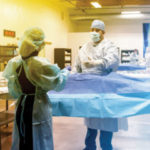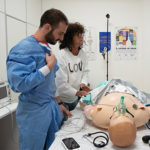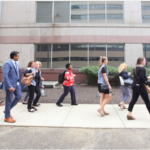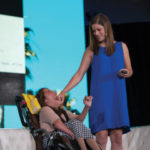
While many medical societies incorporate patient education and outreach into their missions, and plenty of discussion about patient outcomes into their conferences, they tend not to invite any actual patients to participate. Even those medical meetings that offer community-service projects don’t necessarily tailor those activities to the organization’s mission or to the patient communities served by attendees.
But that’s changing. With health-care payers putting increased emphasis on the practices and principles of patient-centered care — which is all about improving patient outcomes by bolstering the quality of the doctor-patient relationship while decreasing unnecessary testing, prescriptions, hospitalizations, and referrals — more medical societies are looking for ways to integrate them into their annual meetings. Learning about patient-centered care without any patients, however, is a little like learning to drive without a car. That’s a big reason why patients are a hot new trend in medical meetings.
For some organizations, increasing the patient presence at a meeting means including more patient advocates; for others, it’s about offering patient-outreach activities over the course of the meeting. To spark ideas and help medical planners determine how they can incorporate patients into their own meetings, Convene took an up-close look at five conferences with innovative patient-related activities.
AMERICAN COLLEGE OF CARDIOLOGY (ACC)
Patient Engagement Pavilion
WHAT IT IS A large exhibit area featuring nonprofit and patient-advocacy organizations arranged in smaller booths and kiosks on the Expo floor at ACC’s 2015 Scientific Session & Expo (ACC.15), which was held at the San Diego Convention Center on March 14–16. ACC provided space to the organizations free of charge. The Pavilion featured a presentation stage with seating for about 50 attendees, and the schedule of events included interactive exhibits, case presentations, and Q&A sessions.
HOW IT CAME ABOUT The Pavilion, which debuted at ACC.15, grew out of ACC’s Cardio-Smart patient-empowerment initiative. ACC partners with patient-advocacy groups to distribute CardioSmart educational materials, and encourages its cardiologist members to practice patient-centered care, but until this year, patient groups didn’t have much of a presence at the annual meeting, according to Michael Hargrett, CardioSmart team leader. “We always had a CardioSmart pavilion and we talked a lot about patients being part of the care team,” he said, “but we had never integrated the patient into all of the rich discussion and science being distributed at our meeting. This is a way to evolve discussions between patients and providers.”
WHY AT THE ANNUAL MEETING “We have more than 20,000 professionals — key opinion leaders from the clinical side, government officials, the FDA, and all of our members,” Hargrett said. “The partners we work with on patient engagement and community events are great organizations, but they don’t have the size and the depth of ACC. I thought, why not use our meeting and give some of the organizations that we partner with an opportunity to present their program to this larger audience?”
LOGISTICS The Pavilion occupied a prominent space, 20 feet by 50 feet, on the Expo floor. The 12 patient groups who participated were arranged in 10-foot-by-five-foot booths as well as some smaller kiosks. Because the Pavilion concentrated the nonprofits together in one highly visible location, they attracted more interest and traffic than they would have on their own, said Mellanie True Hills, founder and CEO of StopAfib.org, one of the organizations featured in the Pavilion. Having presentations and an educational component also helped attract attendees. “It made it a destination,” True Hills said, “and we had a lot of really great traffic and engagement because of that.”
ADVICE For medical societies looking to increase the patient presence at their meetings, a combined exhibit space like the ACC’s is a smart way to go, True Hills said. “It jump-starts the conversation by showing you take it seriously enough to give it all that space,” she said.
From the planner side, Hargrett cautions against gauging success with traditional metrics. “If you have a session at a meeting and you don’t have 75 people listening to it, you might say, ‘We shouldn’t do it anymore,’” he said. “You can’t use those same metrics with something like this. If you can get 25 people to sit and listen to a presentation, I would say that’s successful.”
AMERICAN DIABETES ASSOCIATION (ADA)
Diabetes Day for the Hospitality Industry
WHAT IT IS Diabetes education and cooking demonstrations for staff of the hotels servicing ADA’s Annual Scientific Sessions.
HOW IT CAME ABOUT As ADA’s director of convention operations, Germaine Schaefer spends a lot of time on hotel site visits. During those trips, people are always talking to her about their own diabetes, or a family member’s. A few years ago, after yet another of these conversations, she decided that diabetes education for the meeting’s hotel partners made more sense than the community-service projects that ADA had been organizing. “In 2009, our meeting was in New Orleans and we went out and helped work on a house destroyed by [Hurricane] Katrina. We got about 30 people — out of 14,000,” Schaefer said. “I started thinking, what does this have to do with diabetes or our mission? At the same time, I was having all these conversations with hotel staff, and I thought, why not do Diabetes 101 for the hotel community?”
WHY AT THE ANNUAL MEETING Rather than a patient-education program for ADA’s host community at large, Schaefer wanted to focus on hotel partners because of the direct link to the meeting. “We come into their hotels, we fill them up for a week, and they’re all super-busy cleaning our rooms but don’t know who we are or why we’re there,” she said. “I thought, what can we leave that’s a lasting reminder and relevant to our mission? It’s a way to give back to the community that makes our meeting possible.”
Also, patient education is part of ADA’s mission. “The meeting itself is focused on the science of diabetes and how we move diabetes forward through science,” Schaefer said. “This is a way to bring patient education, which is integral to our mission, into our meeting.”
LOGISTICS ADA has offered complimentary diabetes education and cooking demonstrations to its hotel partners as part of its Diabetes Day for the Hospitality Industry program since 2012. Each hotel in ADA’s room block can choose from a sit-down lunch-and-learn presentation and cooking demonstration, a cooking demonstration only, or a tabletop exhibit in the employee cafeteria. The programs are led by local ADA members, with support from ADA’s national convention staff.
At the 2014 Scientific Sessions in San Francisco, ADA reached more than 800 people across five hotels; at this year’s meeting in Boston, there were activities across five hotels over two days. On one of those days, the Boston Marriott Copley Place employee cafeteria provided a special menu suggested by ADA staff, and a team of registered dietitians and certified diabetes educators manned an education table, answering questions and distributing information. More than 200 hotel employees stopped by the tabletop display, according to the Marriott’s general manager, Terry Worden.
ADVICE Just as planners tweak educational programming, this sort of activity requires ongoing refinement. “In 2012, we held the sessions in the [Pennsylvania] Convention Center [in Philadelphia],” Schaefer said. “We had a room filled with people in suits and front-office people. It was great to have an audience, but it was not the audience we were trying to reach.
“In 2013, we reached out to the larger hotels and asked if we could host activities on site. That worked really well, but we realized most staff doesn’t have 40 minutes for lunch. So in 2014 we offered more tabletop activities in the cafeteria. Our goal is to reach as many people as possible, and so we need to react and adjust accordingly.”
YANKEE DENTAL CONGRESS
TeamSmile Dental Clinic
WHAT IT IS Free dental cleanings and care provided to low-income children on the exhibit floor of Yankee Dental Congress, New England’s largest dental conference and expo.
HOW IT CAME ABOUT Shannon McCarthy, director of sales for Yankee Dental Congress, saw photos from a TeamSmile event on Facebook. TeamSmile is a national nonprofit organization that partners oral health professionals with professional athletic organizations to provide dental care to underserved children. Typically, TeamSmile events take place at sports arenas. “I thought to myself, maybe we could try it during our show,” McCarthy said. “We’ve got everything there already; we basically just need the kids.”
WHY AT THE ANNUAL MEETING “We have a foundation and we’ve done charity events before, but we’ve never tied it to the local community,” McCarthy said. “I felt that this was something different and would appeal to members looking for new ways to get involved and participate in our organization.”
LOGISTICS TeamSmile made its debut at the 2015 Yankee Dental Congress, held Jan. 28–Feb. 1 at the Boston Convention & Exhibition Center (BCEC). The organization, which offers its program to “hosts” on a flat-fee basis, supplied and transported all the necessary equipment to the BCEC. The convention center provided the necessary air, electrical, and water hookups at no charge. McCarthy recruited volunteers via the meeting’s promotional materials in the months leading up to the show. She also reached out to dental schools in the area. In all, she registered 250 volunteers to work four-hour shifts each over two days. The volunteers included general dentists, pediatric specialists, hygienists, and dental students.
The BCEC has relationships with schools and community centers in its South Boston neighborhood, and was able to recruit 600 children for dental checkups and cleanings. Unfortunately, a blizzard struck just before the meeting’s start, and all school and after-school activities were canceled. “We had everything in place and ready to go,” McCarthy said, “but because of the storm, we were able to service only a very small number of kids.”
Despite the disappointing end result, people are committed to try again in 2016, according to Peter Hjorth, DDS, who served as general chair of this year’s meeting. “There was a lot of interest and people asking if they could be involved next year,” Hjorth said. “It created such a positive buzz that now everybody is determined to make it happen.”
ADVICE A creative community-outreach program can help generate enthusiasm about the meeting as a whole, McCarthy said. “We’ve come to the point where trade shows are starting to all look the same. Sometimes you don’t realize you’re at a different show unless you step outside and see the weather,” she said. “By offering something different, it makes the experience more unique for our members and they are more excited about the program as a whole.”
AMERICAN SOCIETY OF CLINICAL ONCOLOGY (ASCO)
Patient-Advocate Programs
WHAT IT IS ASCO offers patient advocates a variety of opportunities to participate in its Annual Meeting, including a Patient Advocate Scholarship Program; an ASCO-sponsored Patient Advocacy Booth, which provides comped space for 28 patient-advocacy organizations; discounted individual exhibit booths for additional patient-advocacy organizations; and a designated Patient Advocate Lounge.
HOW IT CAME ABOUT Because ASCO’s mission is centered around improving the treatment and care of people living with cancer, it has a long history with patient-advocacy organizations. In recent years, ASCO expanded its programs to grant more patient advocates access to the clinicians and researchers gathered at the world’s largest oncology meeting. “Originally, we wanted to make it affordable for patient advocates, so we offered a discounted rate,” said Jeanine Salamone, ASCO’s director of patient advocacy. “As more and more started coming to the meeting, we worked with our foundation to start a scholarship program.”
WHY AT THE ANNUAL MEETING “They deserve to be there, too,” Salamone said. “They’re interested in the science and research, and want to be a part of those conversations.” Kathy Oliver, founding co-director and chair of the International Brain Tumour Alliance, a UK-based patient-advocacy organization that exhibited in the Patient Advocacy Booth this year, added: “We have to remember the whole reason for these conferences is to develop better treatments for patients. Including patient advocates in the annual meeting is a great opportunity for physicians to hear patient perspectives that they might not pick up in their busy, day-to-day practice.”
LOGISTICS Between 300 and 350 patient advocates (out of 30,000 total attendees) attended ASCO’s 2015 Annual Meeting at McCormick Place in Chicago on May 29–June 2, with the Patient Advocate Scholarships helping cover travel, hotel, and registration expenses for a number of them. In all, ASCO has awarded more than $1 million in scholarships to more than 600 advocates since launching the program in 2007.
Each year, patient-advocacy organizations apply for space in ASCO’s Patient Advocacy Booth, which this year housed 28 of them in a 30-foot-by-60-foot space located near the main entrance to the show floor. “Aside from it being front and center in the exhibit hall,” Salamone said, “it was featured as a premier booth on the online map and there was an article about it in the show daily.”
ADVICE Planners should do their homework before instituting any patient-advocate programs. “Don’t think you know what advocates want out of your meeting,” Salamone said. “Ask them what they want, and work with them one-on-one to make that happen.”
HEART RHYTHM SOCIETY (HRS)
‘Living With Atrial Fibrillation’ Educational Event
WHAT IT IS fter several years of conducting citywide awareness campaigns related to cardiac health in the locale of its Annual Scientific Sessions, HRS scaled back this year with a smaller, more focused patient-education program for patients and caregivers. Co-organized with the American College of Cardiology (ACC), “Living With Atrial Fibrillation” was offered both at Heart Rhythm 2015, held at the Boston Convention and Exhibition Center on May 13–16, and at ACC.15 in San Diego.
HOW IT CAME ABOUT “Several years ago, we wanted to draw awareness to the disease states that we’re focused on,” said Christina Wurster, HRS’s vice president of brand, “and also give back to the city hosting our Scientific Sessions.” Working with a public-relations firm, HRS conducted citywide awareness campaigns at its meetings from 2012 to 2014. In addition to having the month of the meeting proclaimed Arrhythmia Awareness Month, HRS hosted patient-education events around its host city, conducted screenings, and did media outreach. After a few years, however, the expense and staff commitment became cumbersome.
“While our attendees found it interesting and applauded us for doing it, it’s not like that many of them were participating. They were busy attending sessions,” Wurster said. “This year, we shifted to the patient education. Even though it’s a smaller number of people participating, these are the patients who are already living with the disease, so the quality of the interaction was much more compelling than the broad-based public-awareness events.”
WHY AT THE ANNUAL MEETING “It’s about being good stewards and trying to deliver on our mission,” Wurster said. “Our mission is to end suffering due to heart-rhythm disorders, educate the public, and serve our patients, so it’s a nice connection. It’s also a way to show our attendees that the Society is actively participating in all the activities of our mission.”
LOGISTICS HRS promoted “Living With Atrial Fibrillation” via area members in Boston and San Diego, local support programs, and a patient-advocacy organization. An area physician led the lunch-and-learn at both the HRS and ACC meetings. Each program was held at the meeting’s headquarters hotel (The Westin Boston Waterfront for HRS, the Hilton San Diego Bayfront for ACC) and drew about 100 patients and caregivers.
ADVICE While a citywide awareness campaign might seem like a fun, high-profile way to generate interest in your meeting, Wurster cautions against biting off too much. “As planners, we’re focused on serving the needs of the attendees, first and foremost,” she said. “A lot of people want to do something big and creative, but when you stack it up against the reason you’re there, which is the business of the meeting, it can become a logistical challenge.”



